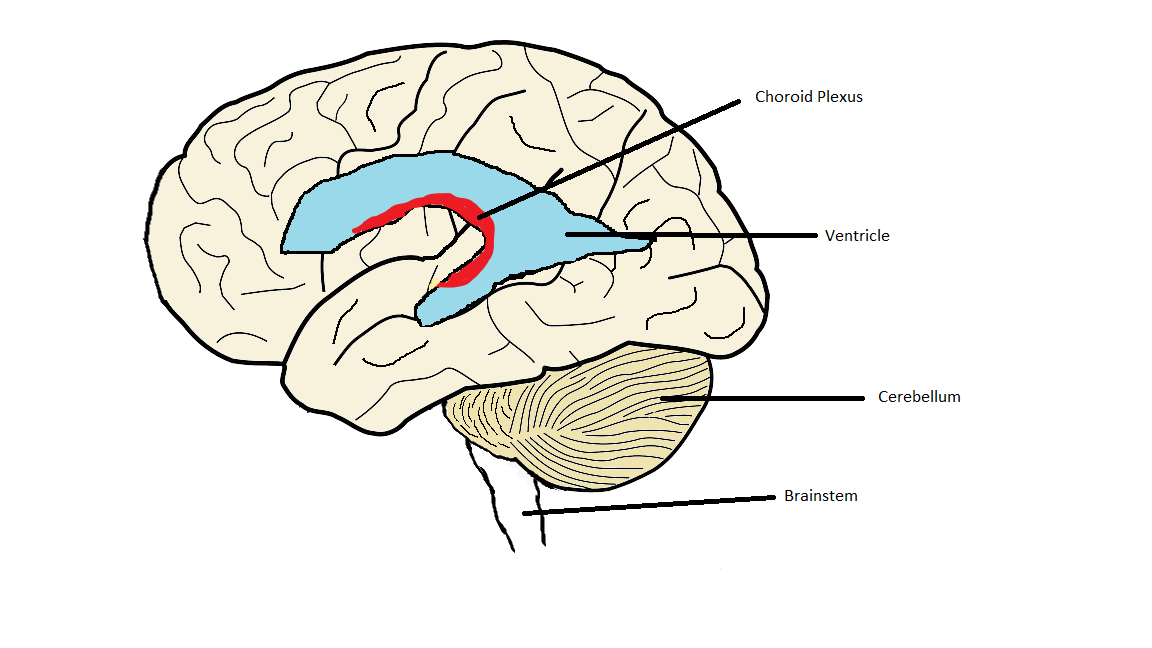There are several different types of bleeding that can happen in a premature baby's brain, the most common is intraventricular hemorrhage (also referred to as "IVH") which is what is discussed here.
Why does it happen?
Premature babies are at risk for bleeding in the spaces inside their brain called the ventricles (see the figure at the bottom of this post). There are very fragile blood vessels within the ventricles that can easily break and lead to bleeding. You baby will likely have a head ultrasound within the first few days of life (similar to the ultrasounds that were done during pregnancy, so no radiation and no significant stress on the infant) to look and see if there is any bleeding. This will be done at the bedside and uses the anterior fontanelle, or soft spot, on the top of the baby's head to get a view of the brain. If any bleeding is seen, your baby's doctors may want to get another head ultrasound in a few days to monitor the bleed and make sure it is not getting worse.
What is the treatment?
Initially, your baby's doctors will watch your baby very closely and make sure that the bleeding has stopped; this is done by getting ultrasounds of your baby's brain. With small bleeds, your baby's brain will be able to get rid of the blood on their own once the bleeding has stopped and nothing further with need to be done. If your baby has a very large bleed, your baby will probably get frequent head ultrasounds to monitor the size of the ventricles. Sometimes, the brain is not able to get rid of the blood because there is so much and this may cause the ventricles to get bigger. If this happens and the ventricles continue to grow in size, your baby may be diagnosed with hydrocephalus which means increase size of the ventricles. Depending on the size of the ventricles, your baby may need a sugery (often many weeks later once they have grown much larger).
What are the long term effects of IVH?
That depends on how big the bleed is. The radiologists (doctors who specialize in reading, xrays, ultrasounds, MRIs, CTscans etc) that look at the images of your baby's brain will grade the degree of bleeding.
There are 4 grades:
Why does it happen?
Premature babies are at risk for bleeding in the spaces inside their brain called the ventricles (see the figure at the bottom of this post). There are very fragile blood vessels within the ventricles that can easily break and lead to bleeding. You baby will likely have a head ultrasound within the first few days of life (similar to the ultrasounds that were done during pregnancy, so no radiation and no significant stress on the infant) to look and see if there is any bleeding. This will be done at the bedside and uses the anterior fontanelle, or soft spot, on the top of the baby's head to get a view of the brain. If any bleeding is seen, your baby's doctors may want to get another head ultrasound in a few days to monitor the bleed and make sure it is not getting worse.
What is the treatment?
Initially, your baby's doctors will watch your baby very closely and make sure that the bleeding has stopped; this is done by getting ultrasounds of your baby's brain. With small bleeds, your baby's brain will be able to get rid of the blood on their own once the bleeding has stopped and nothing further with need to be done. If your baby has a very large bleed, your baby will probably get frequent head ultrasounds to monitor the size of the ventricles. Sometimes, the brain is not able to get rid of the blood because there is so much and this may cause the ventricles to get bigger. If this happens and the ventricles continue to grow in size, your baby may be diagnosed with hydrocephalus which means increase size of the ventricles. Depending on the size of the ventricles, your baby may need a sugery (often many weeks later once they have grown much larger).
What are the long term effects of IVH?
That depends on how big the bleed is. The radiologists (doctors who specialize in reading, xrays, ultrasounds, MRIs, CTscans etc) that look at the images of your baby's brain will grade the degree of bleeding.
There are 4 grades:
- Grade 1. Bleeding occurs just in a small area of the ventricles.
- Grade 2. Bleeding also occurs inside the ventricles.
- Grade 3. Ventricles are enlarged by the blood.
- Grade 4. Bleeding occurs in the brain tissues around the ventricles.

